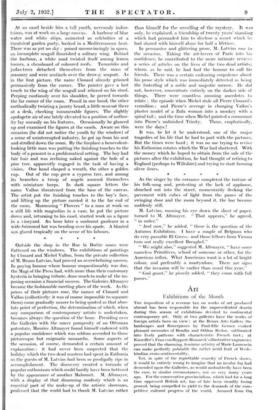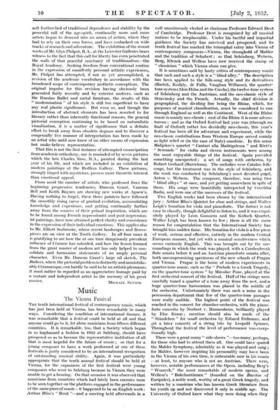Art
Exhibitions of the Month
TIIE imposition of a revenue tax on works of art produced abroad has been responsible for the unprecedented dearth during this season of exhibitions devoted to continental contemporary art. Only at two galleries have the works of foreign artists been on view : at the Beaux Arts Gallery the landscapes and flowerpieees by Paul-Elic Gernez evoked pleasant memories of Boudin and Odilon Redon, sublimated into lively patterns with characteristic French tact ; at Knoedler's Frau von Reppert-Bismarek's illustrative vagrancies proved that the charming, feminine artistry of Marie Laurencin can make perfectly palatable the rather acrid fruit of Wede- kindian eroto-sentimentality.
Yet, in spite of the regrettable scarcity of French shows, it would be entirely wrong to imagine that an insular fog had descended upon the Galleries, as would undoubtedly have been the case, in similar circumstances, not so very many years ago. For the conservative provincialism, which had for a long time oppressed British art, has of late been steadily losing ground, being compelled to yield to the demands of the com- petitive cultural progress of the world. Aroused from the' soft feather-bed of traditional dependence and stability by the powerful call of the age-spirit, continually more and more artists began to descend into an arena of action, where they had to rely on their own forces, and have embarked on wide tracks of research and adventure. The exhibition of the recent works of Mr. Glyn Philpot, R.A., at the Leicester Galleries bears witness to the fact that this call for liberty has even penetrated the walls of that peaceful sanctuary of traditionalism—the Royal Academy. Seeking freedom from conventional routine in the expression of manifestly personal artistic experiences, Mr. Philpot has attempted, if not as yet accomplished, a revision of the academic vocabulary in accordance with the broadened scope of contemporary aesthetic conceptions. The original impulse for this revision having obviously been generated fairly recently and by exterior motives, such as the Russian Ballet and metal furniture, the results of this " modernisation " of his style is still too superficial to have any real plastic significance. But even so, and though the introduction of abstract elements has been resorted to for literary rather than inherently functional reasons, the general pictorial conception continuing to be based on naturalistic Visualization, it is a matter of significance that a definite effort to break away from obsolete dogmas and to discover a congenially live manner of interpretation has been made by an artist who until now knew of no other means of expression but make-believe representation.
That this is not the first instance of attempted emancipation from academic orthodoxy, one is reminded of by seven pictures which the late Charles Sims, R.A., painted during the last year of his life, and which are included in an exhibition of modern paintings at the Redfern Gallery. These pictures, strongly tinged with mysticism, possess more theoretic interest than emotional appeal.
From amid the number of artists who professed from the beginning progressive tendencies, Duncan Grant, Vanessa Bell and Keith Baynes are showing new works at Agnew's. Having nothing to forget, these three painters have followed the smoothly rising curve of gradual evolution, accumulating knowledge and experience, and getting continually further away from the sources of their primal inspiration, which are to be found among French impressionist and post-impression- ist paintings, have now attained perfect clarity and consistence in the expression of their individual emotions. This applies also to Mr. Elliott Seabrooke, whose recent landscapes and flower- pieces are on view at the Tooth Gallery. In all four cases it is gratifying to see how the at one time dangerously prevalent influence of Cezanne has subsided, and how the lesson learned from the great master of modern art has only helped to con- solidate and harmonize statements of an amply personal character. Even Mr. Duncan Grant's large oil sketch, The Bathers, where the pictorial problem is distinctly and unmistake- ably Cezannesque, can hardly be said to be an artistic pleonasm; it must rather be regarded as an appreciative homage paid by a mature and independent artist to the memory of his great







































 Previous page
Previous page